Short Staffing of Nurses: Reasons, Effects, and Recommendations
VerifiedAdded on 2023/06/15
|9
|2140
|124
AI Summary
This report discusses the reasons for the shortage of nursing staff, its effects on the healthcare industry, and recommendations to overcome the crisis. It also focuses on the Malaysian context and governmental steps to address the situation.
Contribute Materials
Your contribution can guide someone’s learning journey. Share your
documents today.
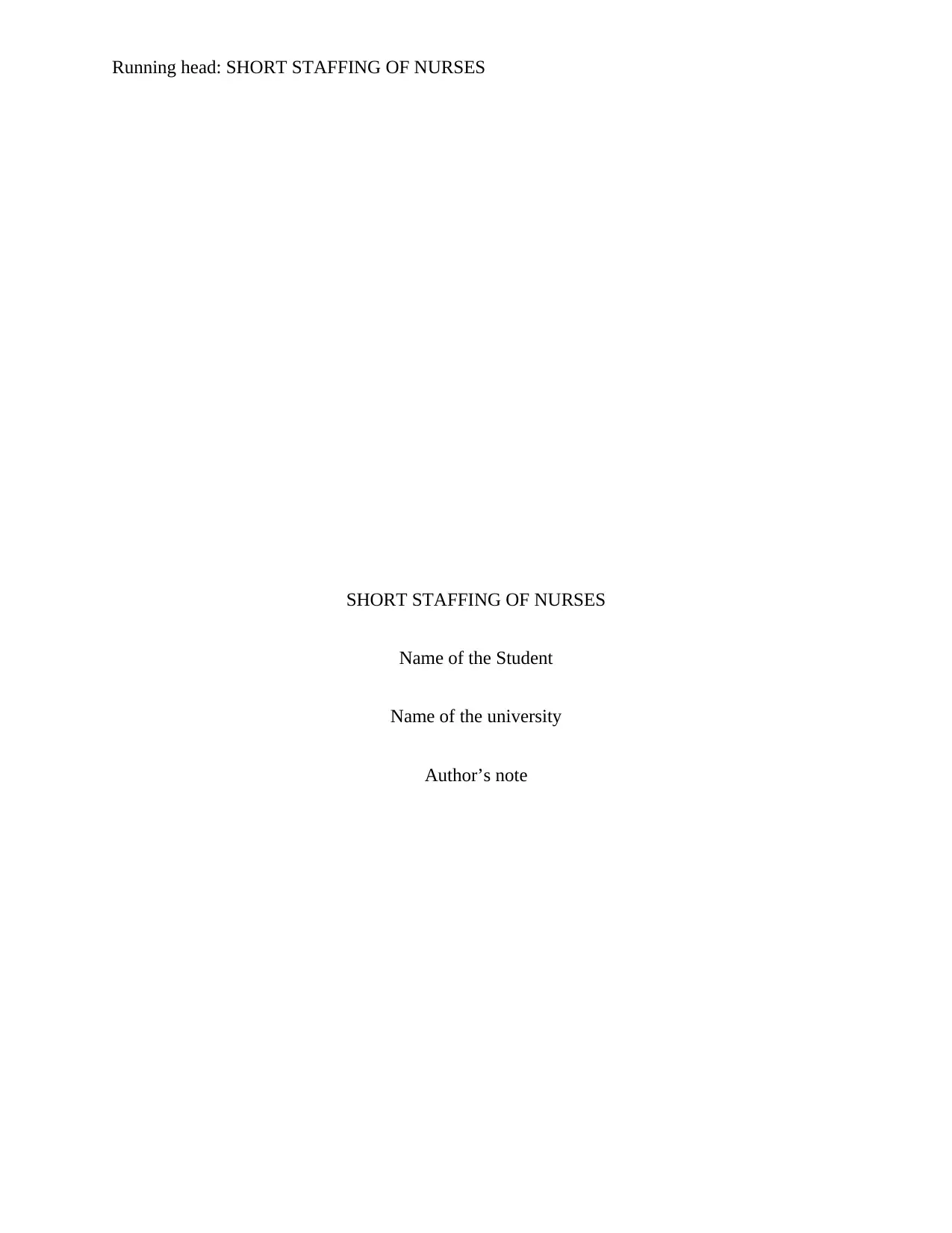
Running head: SHORT STAFFING OF NURSES
SHORT STAFFING OF NURSES
Name of the Student
Name of the university
Author’s note
SHORT STAFFING OF NURSES
Name of the Student
Name of the university
Author’s note
Secure Best Marks with AI Grader
Need help grading? Try our AI Grader for instant feedback on your assignments.
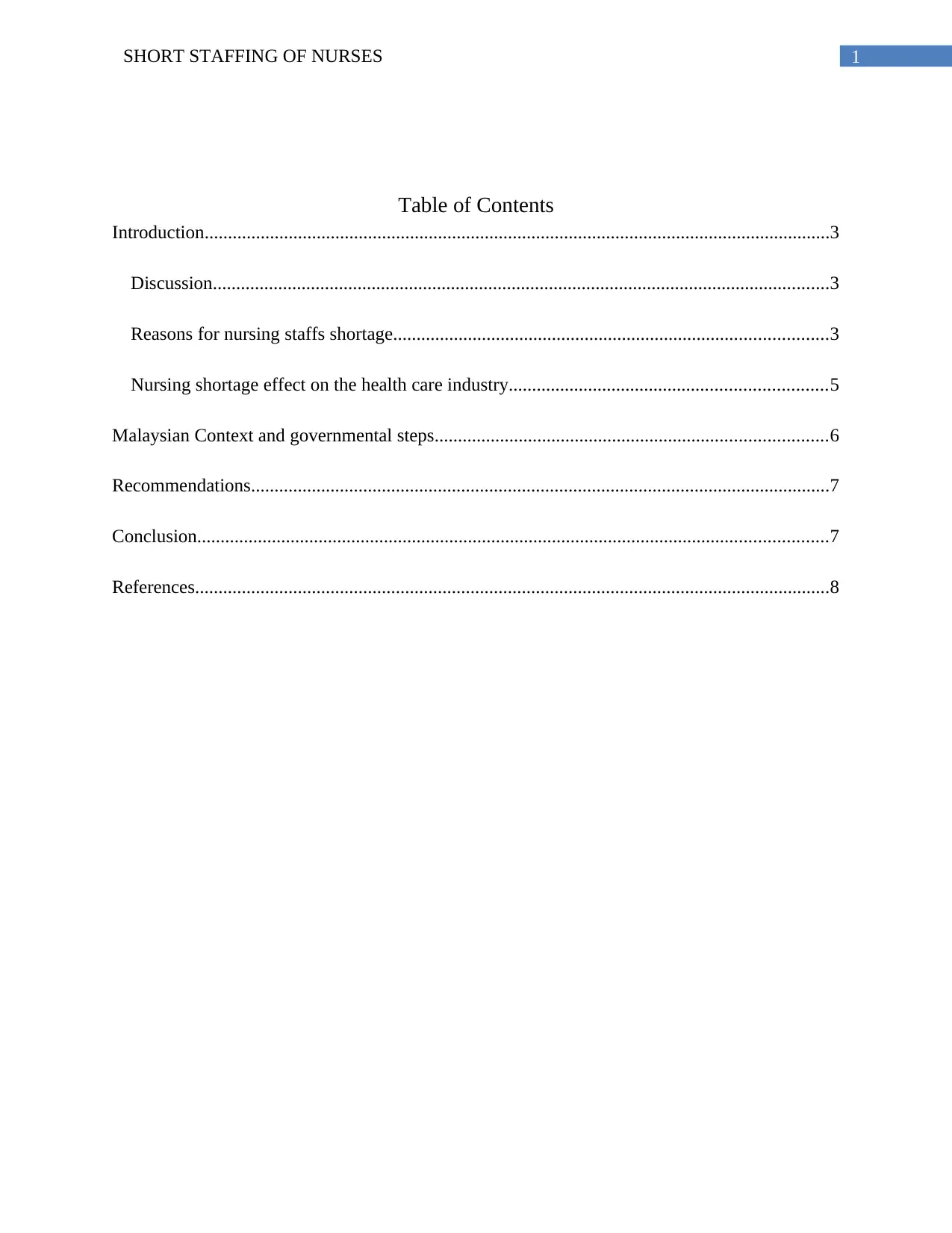
1SHORT STAFFING OF NURSES
Table of Contents
Introduction......................................................................................................................................3
Discussion....................................................................................................................................3
Reasons for nursing staffs shortage.............................................................................................3
Nursing shortage effect on the health care industry....................................................................5
Malaysian Context and governmental steps....................................................................................6
Recommendations............................................................................................................................7
Conclusion.......................................................................................................................................7
References........................................................................................................................................8
Table of Contents
Introduction......................................................................................................................................3
Discussion....................................................................................................................................3
Reasons for nursing staffs shortage.............................................................................................3
Nursing shortage effect on the health care industry....................................................................5
Malaysian Context and governmental steps....................................................................................6
Recommendations............................................................................................................................7
Conclusion.......................................................................................................................................7
References........................................................................................................................................8
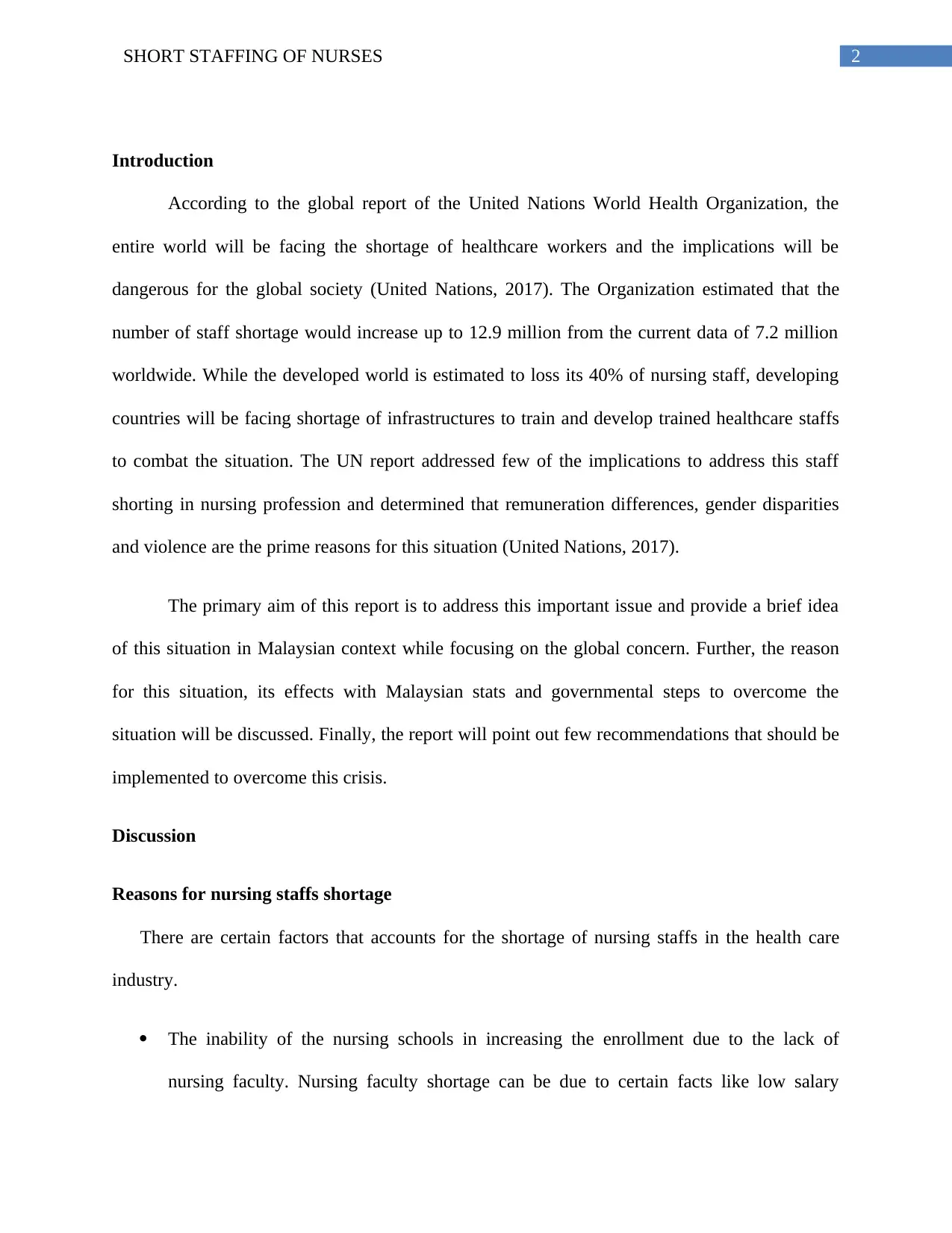
2SHORT STAFFING OF NURSES
Introduction
According to the global report of the United Nations World Health Organization, the
entire world will be facing the shortage of healthcare workers and the implications will be
dangerous for the global society (United Nations, 2017). The Organization estimated that the
number of staff shortage would increase up to 12.9 million from the current data of 7.2 million
worldwide. While the developed world is estimated to loss its 40% of nursing staff, developing
countries will be facing shortage of infrastructures to train and develop trained healthcare staffs
to combat the situation. The UN report addressed few of the implications to address this staff
shorting in nursing profession and determined that remuneration differences, gender disparities
and violence are the prime reasons for this situation (United Nations, 2017).
The primary aim of this report is to address this important issue and provide a brief idea
of this situation in Malaysian context while focusing on the global concern. Further, the reason
for this situation, its effects with Malaysian stats and governmental steps to overcome the
situation will be discussed. Finally, the report will point out few recommendations that should be
implemented to overcome this crisis.
Discussion
Reasons for nursing staffs shortage
There are certain factors that accounts for the shortage of nursing staffs in the health care
industry.
The inability of the nursing schools in increasing the enrollment due to the lack of
nursing faculty. Nursing faculty shortage can be due to certain facts like low salary
Introduction
According to the global report of the United Nations World Health Organization, the
entire world will be facing the shortage of healthcare workers and the implications will be
dangerous for the global society (United Nations, 2017). The Organization estimated that the
number of staff shortage would increase up to 12.9 million from the current data of 7.2 million
worldwide. While the developed world is estimated to loss its 40% of nursing staff, developing
countries will be facing shortage of infrastructures to train and develop trained healthcare staffs
to combat the situation. The UN report addressed few of the implications to address this staff
shorting in nursing profession and determined that remuneration differences, gender disparities
and violence are the prime reasons for this situation (United Nations, 2017).
The primary aim of this report is to address this important issue and provide a brief idea
of this situation in Malaysian context while focusing on the global concern. Further, the reason
for this situation, its effects with Malaysian stats and governmental steps to overcome the
situation will be discussed. Finally, the report will point out few recommendations that should be
implemented to overcome this crisis.
Discussion
Reasons for nursing staffs shortage
There are certain factors that accounts for the shortage of nursing staffs in the health care
industry.
The inability of the nursing schools in increasing the enrollment due to the lack of
nursing faculty. Nursing faculty shortage can be due to certain facts like low salary
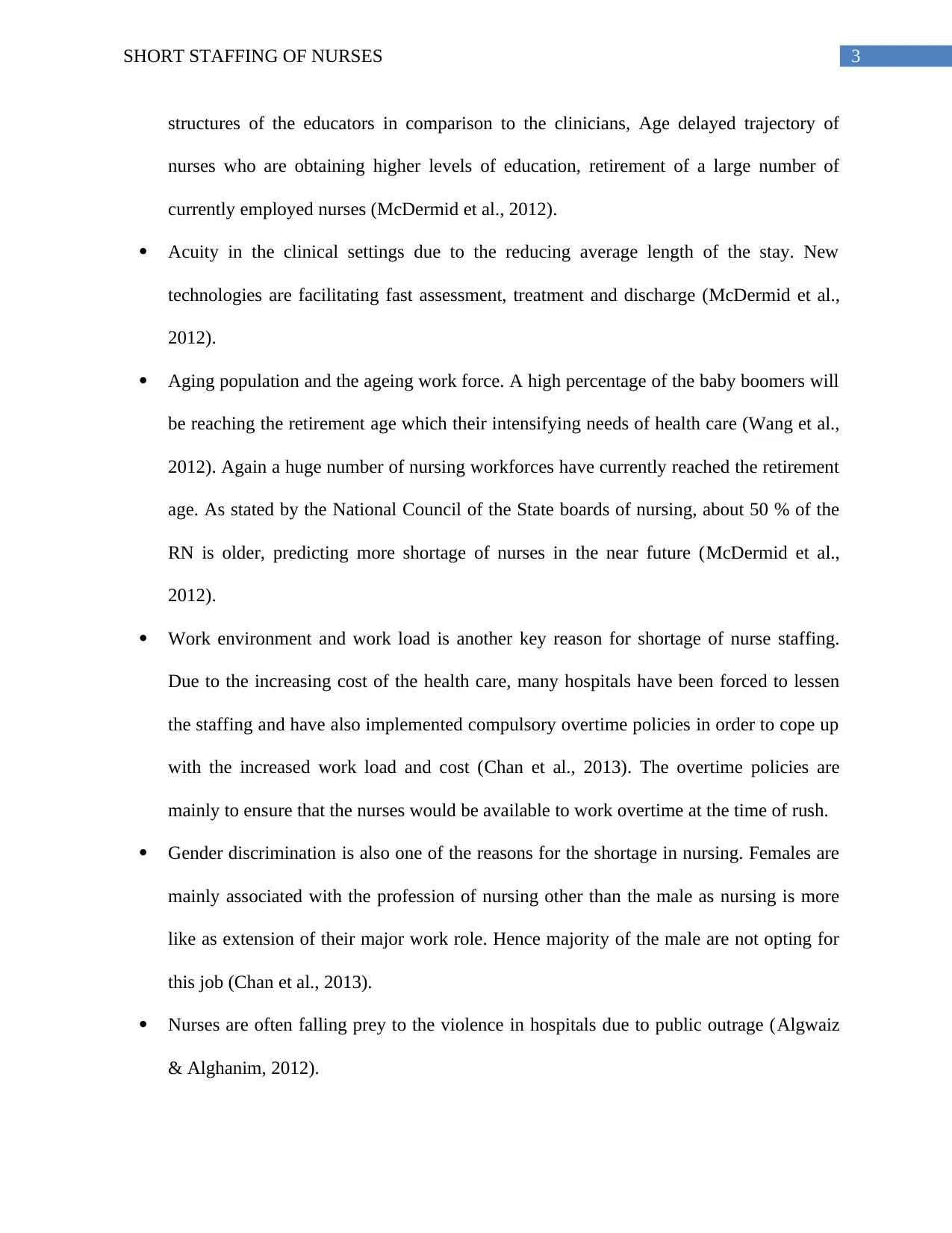
3SHORT STAFFING OF NURSES
structures of the educators in comparison to the clinicians, Age delayed trajectory of
nurses who are obtaining higher levels of education, retirement of a large number of
currently employed nurses (McDermid et al., 2012).
Acuity in the clinical settings due to the reducing average length of the stay. New
technologies are facilitating fast assessment, treatment and discharge (McDermid et al.,
2012).
Aging population and the ageing work force. A high percentage of the baby boomers will
be reaching the retirement age which their intensifying needs of health care (Wang et al.,
2012). Again a huge number of nursing workforces have currently reached the retirement
age. As stated by the National Council of the State boards of nursing, about 50 % of the
RN is older, predicting more shortage of nurses in the near future (McDermid et al.,
2012).
Work environment and work load is another key reason for shortage of nurse staffing.
Due to the increasing cost of the health care, many hospitals have been forced to lessen
the staffing and have also implemented compulsory overtime policies in order to cope up
with the increased work load and cost (Chan et al., 2013). The overtime policies are
mainly to ensure that the nurses would be available to work overtime at the time of rush.
Gender discrimination is also one of the reasons for the shortage in nursing. Females are
mainly associated with the profession of nursing other than the male as nursing is more
like as extension of their major work role. Hence majority of the male are not opting for
this job (Chan et al., 2013).
Nurses are often falling prey to the violence in hospitals due to public outrage (Algwaiz
& Alghanim, 2012).
structures of the educators in comparison to the clinicians, Age delayed trajectory of
nurses who are obtaining higher levels of education, retirement of a large number of
currently employed nurses (McDermid et al., 2012).
Acuity in the clinical settings due to the reducing average length of the stay. New
technologies are facilitating fast assessment, treatment and discharge (McDermid et al.,
2012).
Aging population and the ageing work force. A high percentage of the baby boomers will
be reaching the retirement age which their intensifying needs of health care (Wang et al.,
2012). Again a huge number of nursing workforces have currently reached the retirement
age. As stated by the National Council of the State boards of nursing, about 50 % of the
RN is older, predicting more shortage of nurses in the near future (McDermid et al.,
2012).
Work environment and work load is another key reason for shortage of nurse staffing.
Due to the increasing cost of the health care, many hospitals have been forced to lessen
the staffing and have also implemented compulsory overtime policies in order to cope up
with the increased work load and cost (Chan et al., 2013). The overtime policies are
mainly to ensure that the nurses would be available to work overtime at the time of rush.
Gender discrimination is also one of the reasons for the shortage in nursing. Females are
mainly associated with the profession of nursing other than the male as nursing is more
like as extension of their major work role. Hence majority of the male are not opting for
this job (Chan et al., 2013).
Nurses are often falling prey to the violence in hospitals due to public outrage (Algwaiz
& Alghanim, 2012).
Secure Best Marks with AI Grader
Need help grading? Try our AI Grader for instant feedback on your assignments.
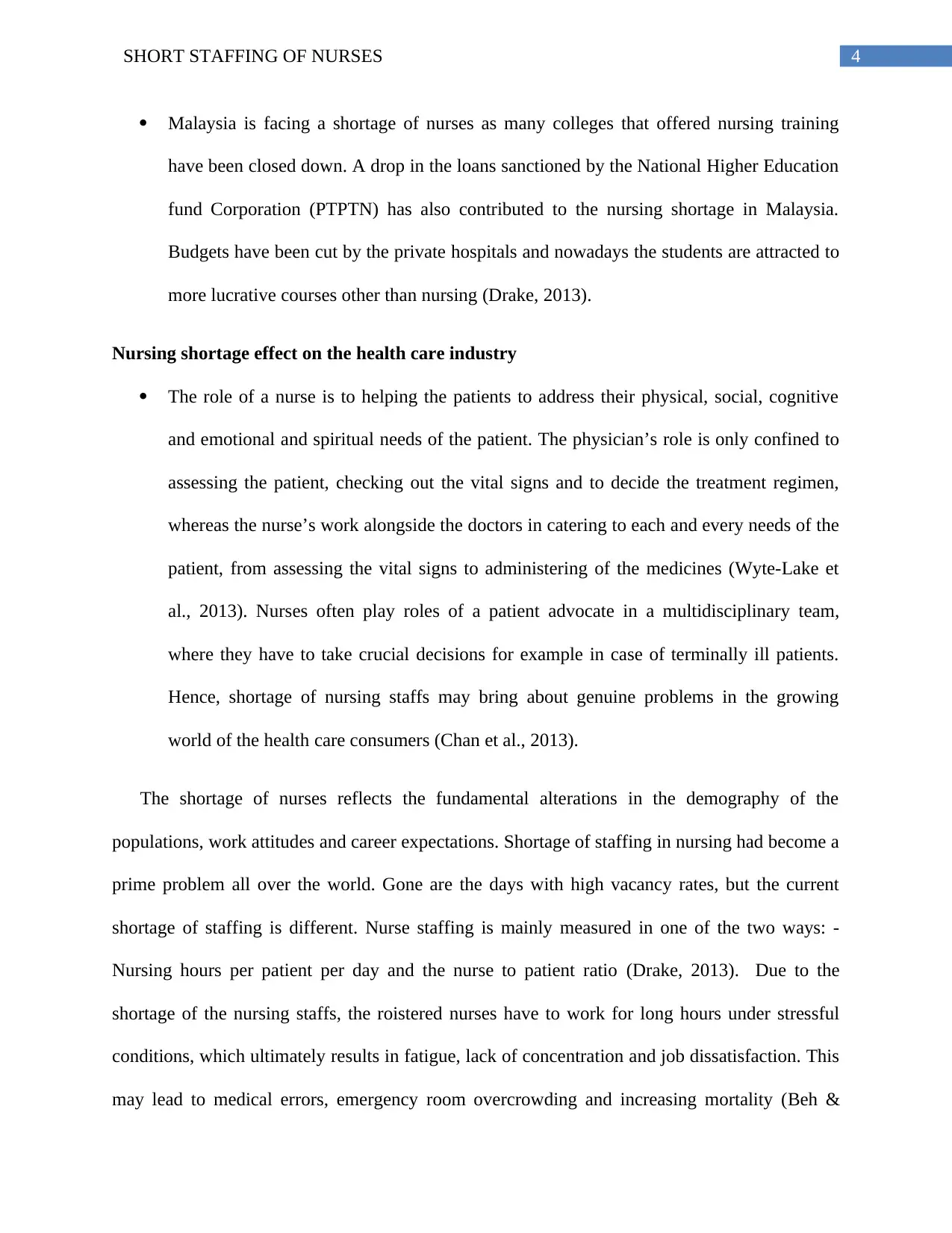
4SHORT STAFFING OF NURSES
Malaysia is facing a shortage of nurses as many colleges that offered nursing training
have been closed down. A drop in the loans sanctioned by the National Higher Education
fund Corporation (PTPTN) has also contributed to the nursing shortage in Malaysia.
Budgets have been cut by the private hospitals and nowadays the students are attracted to
more lucrative courses other than nursing (Drake, 2013).
Nursing shortage effect on the health care industry
The role of a nurse is to helping the patients to address their physical, social, cognitive
and emotional and spiritual needs of the patient. The physician’s role is only confined to
assessing the patient, checking out the vital signs and to decide the treatment regimen,
whereas the nurse’s work alongside the doctors in catering to each and every needs of the
patient, from assessing the vital signs to administering of the medicines (Wyte-Lake et
al., 2013). Nurses often play roles of a patient advocate in a multidisciplinary team,
where they have to take crucial decisions for example in case of terminally ill patients.
Hence, shortage of nursing staffs may bring about genuine problems in the growing
world of the health care consumers (Chan et al., 2013).
The shortage of nurses reflects the fundamental alterations in the demography of the
populations, work attitudes and career expectations. Shortage of staffing in nursing had become a
prime problem all over the world. Gone are the days with high vacancy rates, but the current
shortage of staffing is different. Nurse staffing is mainly measured in one of the two ways: -
Nursing hours per patient per day and the nurse to patient ratio (Drake, 2013). Due to the
shortage of the nursing staffs, the roistered nurses have to work for long hours under stressful
conditions, which ultimately results in fatigue, lack of concentration and job dissatisfaction. This
may lead to medical errors, emergency room overcrowding and increasing mortality (Beh &
Malaysia is facing a shortage of nurses as many colleges that offered nursing training
have been closed down. A drop in the loans sanctioned by the National Higher Education
fund Corporation (PTPTN) has also contributed to the nursing shortage in Malaysia.
Budgets have been cut by the private hospitals and nowadays the students are attracted to
more lucrative courses other than nursing (Drake, 2013).
Nursing shortage effect on the health care industry
The role of a nurse is to helping the patients to address their physical, social, cognitive
and emotional and spiritual needs of the patient. The physician’s role is only confined to
assessing the patient, checking out the vital signs and to decide the treatment regimen,
whereas the nurse’s work alongside the doctors in catering to each and every needs of the
patient, from assessing the vital signs to administering of the medicines (Wyte-Lake et
al., 2013). Nurses often play roles of a patient advocate in a multidisciplinary team,
where they have to take crucial decisions for example in case of terminally ill patients.
Hence, shortage of nursing staffs may bring about genuine problems in the growing
world of the health care consumers (Chan et al., 2013).
The shortage of nurses reflects the fundamental alterations in the demography of the
populations, work attitudes and career expectations. Shortage of staffing in nursing had become a
prime problem all over the world. Gone are the days with high vacancy rates, but the current
shortage of staffing is different. Nurse staffing is mainly measured in one of the two ways: -
Nursing hours per patient per day and the nurse to patient ratio (Drake, 2013). Due to the
shortage of the nursing staffs, the roistered nurses have to work for long hours under stressful
conditions, which ultimately results in fatigue, lack of concentration and job dissatisfaction. This
may lead to medical errors, emergency room overcrowding and increasing mortality (Beh &
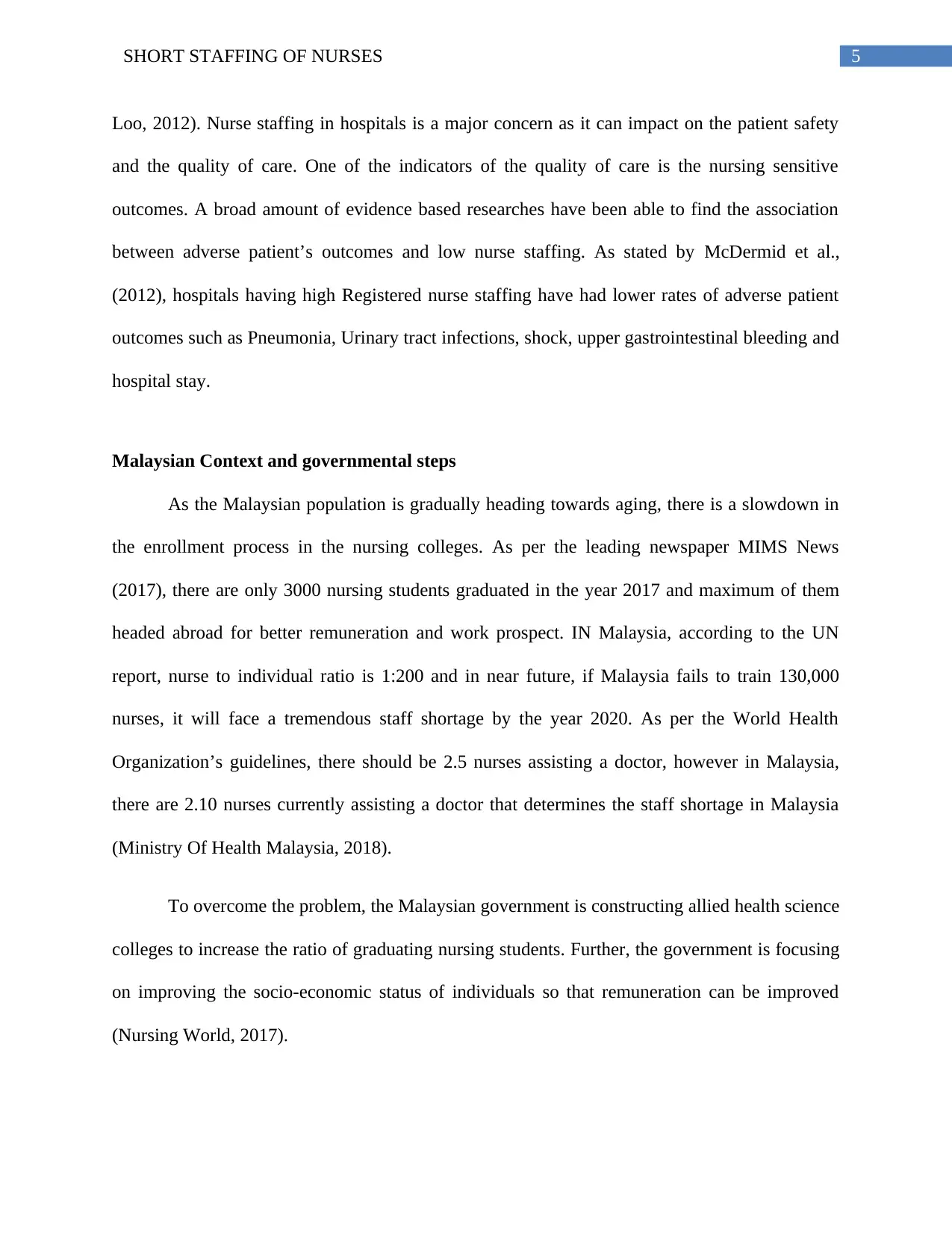
5SHORT STAFFING OF NURSES
Loo, 2012). Nurse staffing in hospitals is a major concern as it can impact on the patient safety
and the quality of care. One of the indicators of the quality of care is the nursing sensitive
outcomes. A broad amount of evidence based researches have been able to find the association
between adverse patient’s outcomes and low nurse staffing. As stated by McDermid et al.,
(2012), hospitals having high Registered nurse staffing have had lower rates of adverse patient
outcomes such as Pneumonia, Urinary tract infections, shock, upper gastrointestinal bleeding and
hospital stay.
Malaysian Context and governmental steps
As the Malaysian population is gradually heading towards aging, there is a slowdown in
the enrollment process in the nursing colleges. As per the leading newspaper MIMS News
(2017), there are only 3000 nursing students graduated in the year 2017 and maximum of them
headed abroad for better remuneration and work prospect. IN Malaysia, according to the UN
report, nurse to individual ratio is 1:200 and in near future, if Malaysia fails to train 130,000
nurses, it will face a tremendous staff shortage by the year 2020. As per the World Health
Organization’s guidelines, there should be 2.5 nurses assisting a doctor, however in Malaysia,
there are 2.10 nurses currently assisting a doctor that determines the staff shortage in Malaysia
(Ministry Of Health Malaysia, 2018).
To overcome the problem, the Malaysian government is constructing allied health science
colleges to increase the ratio of graduating nursing students. Further, the government is focusing
on improving the socio-economic status of individuals so that remuneration can be improved
(Nursing World, 2017).
Loo, 2012). Nurse staffing in hospitals is a major concern as it can impact on the patient safety
and the quality of care. One of the indicators of the quality of care is the nursing sensitive
outcomes. A broad amount of evidence based researches have been able to find the association
between adverse patient’s outcomes and low nurse staffing. As stated by McDermid et al.,
(2012), hospitals having high Registered nurse staffing have had lower rates of adverse patient
outcomes such as Pneumonia, Urinary tract infections, shock, upper gastrointestinal bleeding and
hospital stay.
Malaysian Context and governmental steps
As the Malaysian population is gradually heading towards aging, there is a slowdown in
the enrollment process in the nursing colleges. As per the leading newspaper MIMS News
(2017), there are only 3000 nursing students graduated in the year 2017 and maximum of them
headed abroad for better remuneration and work prospect. IN Malaysia, according to the UN
report, nurse to individual ratio is 1:200 and in near future, if Malaysia fails to train 130,000
nurses, it will face a tremendous staff shortage by the year 2020. As per the World Health
Organization’s guidelines, there should be 2.5 nurses assisting a doctor, however in Malaysia,
there are 2.10 nurses currently assisting a doctor that determines the staff shortage in Malaysia
(Ministry Of Health Malaysia, 2018).
To overcome the problem, the Malaysian government is constructing allied health science
colleges to increase the ratio of graduating nursing students. Further, the government is focusing
on improving the socio-economic status of individuals so that remuneration can be improved
(Nursing World, 2017).
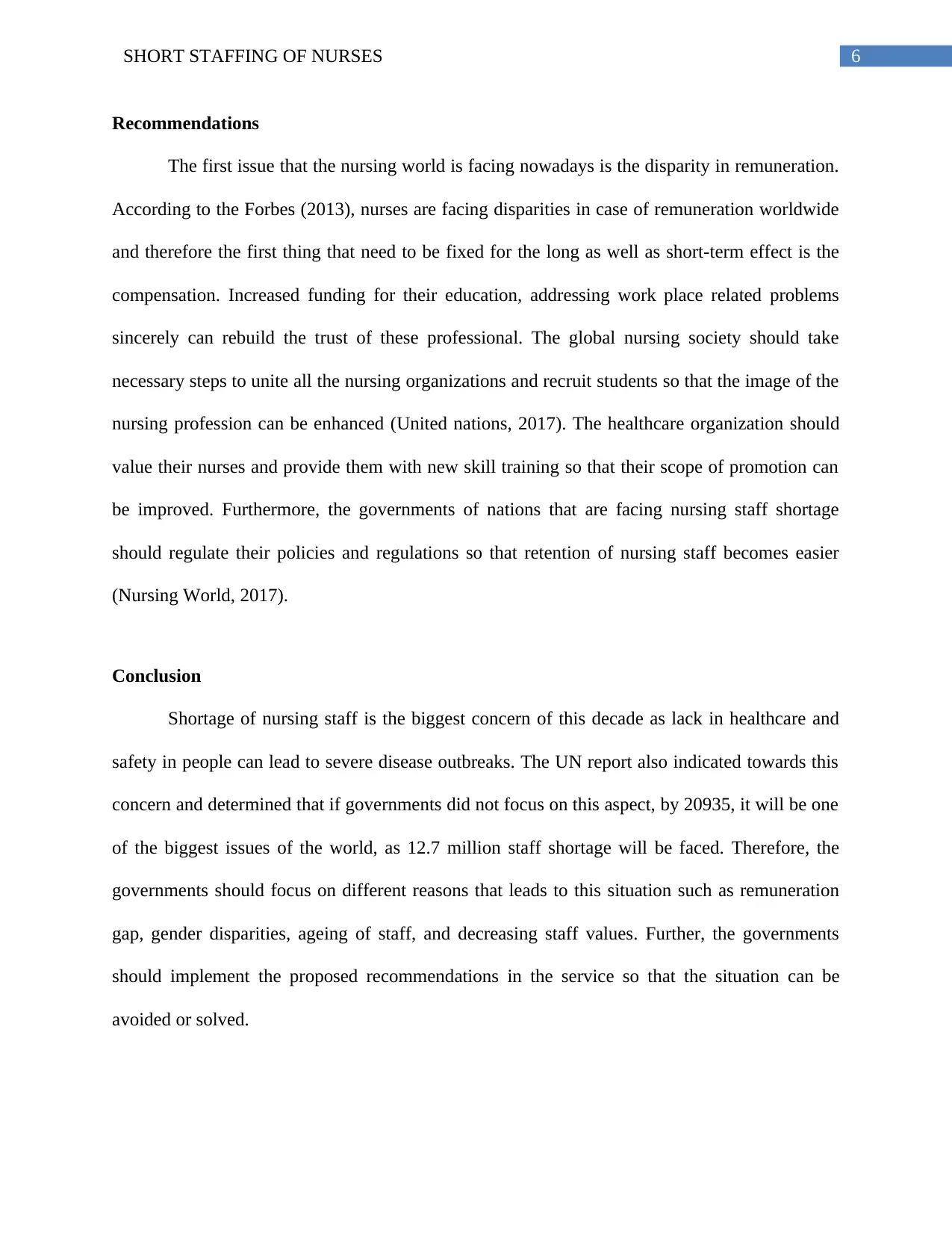
6SHORT STAFFING OF NURSES
Recommendations
The first issue that the nursing world is facing nowadays is the disparity in remuneration.
According to the Forbes (2013), nurses are facing disparities in case of remuneration worldwide
and therefore the first thing that need to be fixed for the long as well as short-term effect is the
compensation. Increased funding for their education, addressing work place related problems
sincerely can rebuild the trust of these professional. The global nursing society should take
necessary steps to unite all the nursing organizations and recruit students so that the image of the
nursing profession can be enhanced (United nations, 2017). The healthcare organization should
value their nurses and provide them with new skill training so that their scope of promotion can
be improved. Furthermore, the governments of nations that are facing nursing staff shortage
should regulate their policies and regulations so that retention of nursing staff becomes easier
(Nursing World, 2017).
Conclusion
Shortage of nursing staff is the biggest concern of this decade as lack in healthcare and
safety in people can lead to severe disease outbreaks. The UN report also indicated towards this
concern and determined that if governments did not focus on this aspect, by 20935, it will be one
of the biggest issues of the world, as 12.7 million staff shortage will be faced. Therefore, the
governments should focus on different reasons that leads to this situation such as remuneration
gap, gender disparities, ageing of staff, and decreasing staff values. Further, the governments
should implement the proposed recommendations in the service so that the situation can be
avoided or solved.
Recommendations
The first issue that the nursing world is facing nowadays is the disparity in remuneration.
According to the Forbes (2013), nurses are facing disparities in case of remuneration worldwide
and therefore the first thing that need to be fixed for the long as well as short-term effect is the
compensation. Increased funding for their education, addressing work place related problems
sincerely can rebuild the trust of these professional. The global nursing society should take
necessary steps to unite all the nursing organizations and recruit students so that the image of the
nursing profession can be enhanced (United nations, 2017). The healthcare organization should
value their nurses and provide them with new skill training so that their scope of promotion can
be improved. Furthermore, the governments of nations that are facing nursing staff shortage
should regulate their policies and regulations so that retention of nursing staff becomes easier
(Nursing World, 2017).
Conclusion
Shortage of nursing staff is the biggest concern of this decade as lack in healthcare and
safety in people can lead to severe disease outbreaks. The UN report also indicated towards this
concern and determined that if governments did not focus on this aspect, by 20935, it will be one
of the biggest issues of the world, as 12.7 million staff shortage will be faced. Therefore, the
governments should focus on different reasons that leads to this situation such as remuneration
gap, gender disparities, ageing of staff, and decreasing staff values. Further, the governments
should implement the proposed recommendations in the service so that the situation can be
avoided or solved.
Paraphrase This Document
Need a fresh take? Get an instant paraphrase of this document with our AI Paraphraser
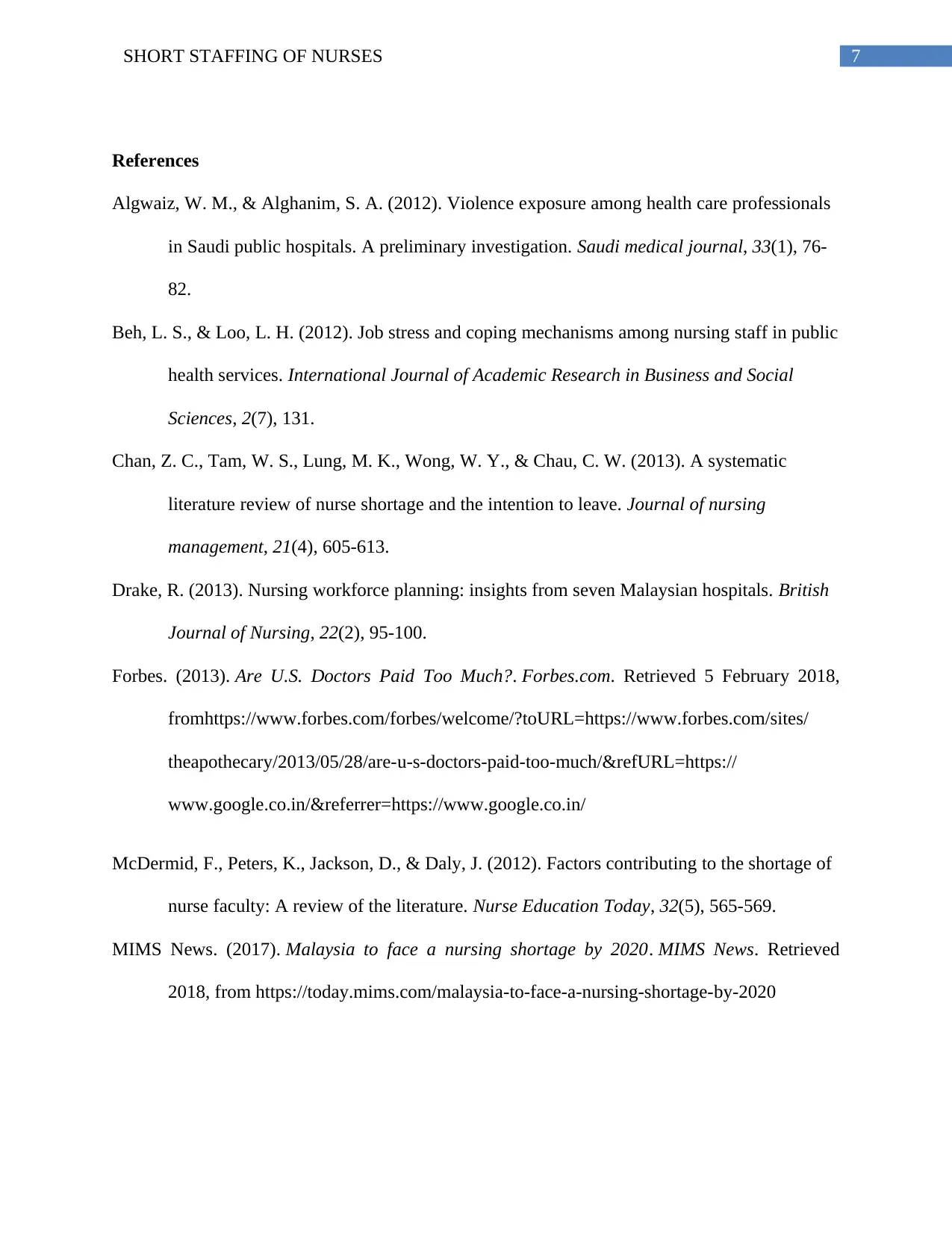
7SHORT STAFFING OF NURSES
References
Algwaiz, W. M., & Alghanim, S. A. (2012). Violence exposure among health care professionals
in Saudi public hospitals. A preliminary investigation. Saudi medical journal, 33(1), 76-
82.
Beh, L. S., & Loo, L. H. (2012). Job stress and coping mechanisms among nursing staff in public
health services. International Journal of Academic Research in Business and Social
Sciences, 2(7), 131.
Chan, Z. C., Tam, W. S., Lung, M. K., Wong, W. Y., & Chau, C. W. (2013). A systematic
literature review of nurse shortage and the intention to leave. Journal of nursing
management, 21(4), 605-613.
Drake, R. (2013). Nursing workforce planning: insights from seven Malaysian hospitals. British
Journal of Nursing, 22(2), 95-100.
Forbes. (2013). Are U.S. Doctors Paid Too Much?. Forbes.com. Retrieved 5 February 2018,
fromhttps://www.forbes.com/forbes/welcome/?toURL=https://www.forbes.com/sites/
theapothecary/2013/05/28/are-u-s-doctors-paid-too-much/&refURL=https://
www.google.co.in/&referrer=https://www.google.co.in/
McDermid, F., Peters, K., Jackson, D., & Daly, J. (2012). Factors contributing to the shortage of
nurse faculty: A review of the literature. Nurse Education Today, 32(5), 565-569.
MIMS News. (2017). Malaysia to face a nursing shortage by 2020. MIMS News. Retrieved
2018, from https://today.mims.com/malaysia-to-face-a-nursing-shortage-by-2020
References
Algwaiz, W. M., & Alghanim, S. A. (2012). Violence exposure among health care professionals
in Saudi public hospitals. A preliminary investigation. Saudi medical journal, 33(1), 76-
82.
Beh, L. S., & Loo, L. H. (2012). Job stress and coping mechanisms among nursing staff in public
health services. International Journal of Academic Research in Business and Social
Sciences, 2(7), 131.
Chan, Z. C., Tam, W. S., Lung, M. K., Wong, W. Y., & Chau, C. W. (2013). A systematic
literature review of nurse shortage and the intention to leave. Journal of nursing
management, 21(4), 605-613.
Drake, R. (2013). Nursing workforce planning: insights from seven Malaysian hospitals. British
Journal of Nursing, 22(2), 95-100.
Forbes. (2013). Are U.S. Doctors Paid Too Much?. Forbes.com. Retrieved 5 February 2018,
fromhttps://www.forbes.com/forbes/welcome/?toURL=https://www.forbes.com/sites/
theapothecary/2013/05/28/are-u-s-doctors-paid-too-much/&refURL=https://
www.google.co.in/&referrer=https://www.google.co.in/
McDermid, F., Peters, K., Jackson, D., & Daly, J. (2012). Factors contributing to the shortage of
nurse faculty: A review of the literature. Nurse Education Today, 32(5), 565-569.
MIMS News. (2017). Malaysia to face a nursing shortage by 2020. MIMS News. Retrieved
2018, from https://today.mims.com/malaysia-to-face-a-nursing-shortage-by-2020
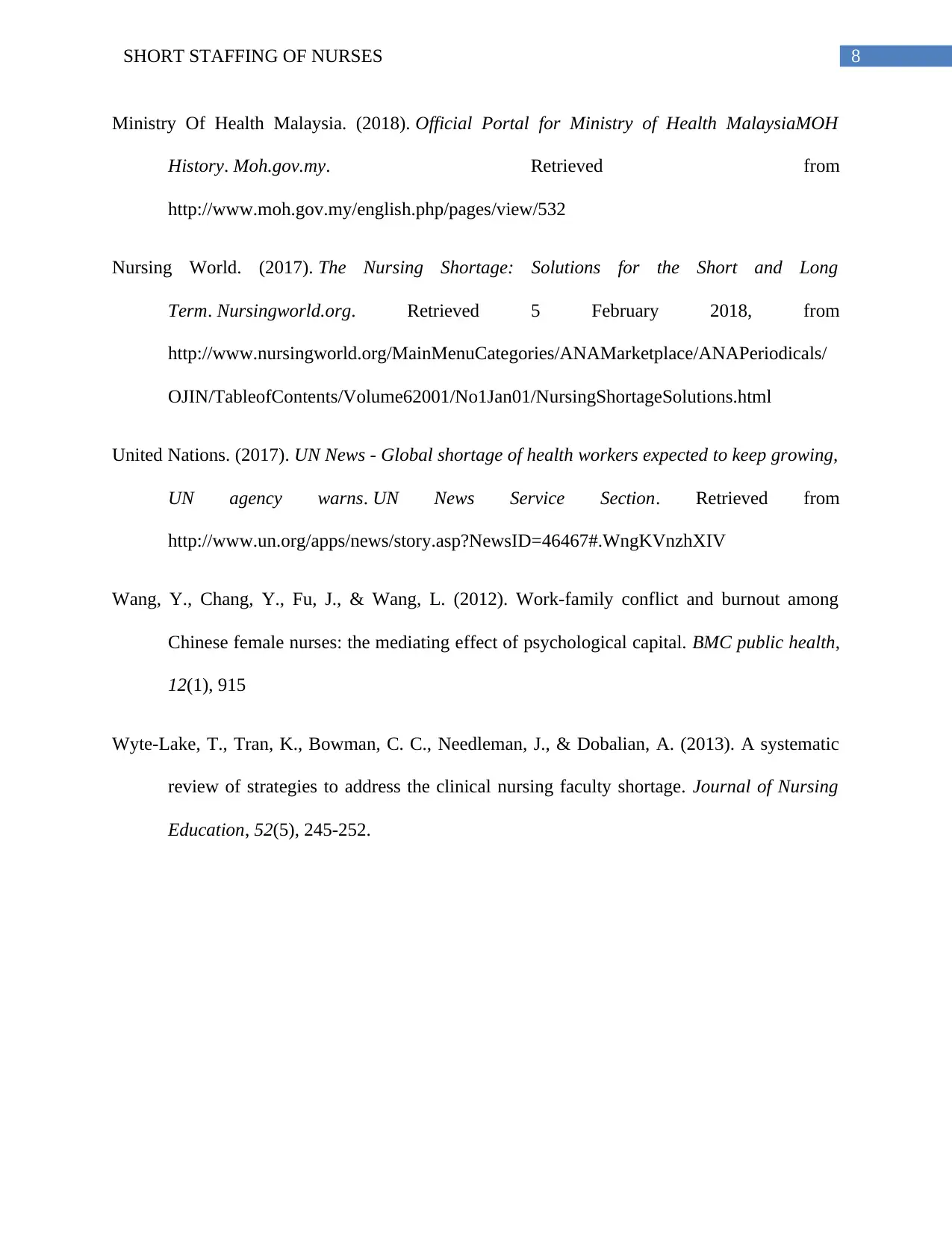
8SHORT STAFFING OF NURSES
Ministry Of Health Malaysia. (2018). Official Portal for Ministry of Health MalaysiaMOH
History. Moh.gov.my. Retrieved from
http://www.moh.gov.my/english.php/pages/view/532
Nursing World. (2017). The Nursing Shortage: Solutions for the Short and Long
Term. Nursingworld.org. Retrieved 5 February 2018, from
http://www.nursingworld.org/MainMenuCategories/ANAMarketplace/ANAPeriodicals/
OJIN/TableofContents/Volume62001/No1Jan01/NursingShortageSolutions.html
United Nations. (2017). UN News - Global shortage of health workers expected to keep growing,
UN agency warns. UN News Service Section. Retrieved from
http://www.un.org/apps/news/story.asp?NewsID=46467#.WngKVnzhXIV
Wang, Y., Chang, Y., Fu, J., & Wang, L. (2012). Work-family conflict and burnout among
Chinese female nurses: the mediating effect of psychological capital. BMC public health,
12(1), 915
Wyte-Lake, T., Tran, K., Bowman, C. C., Needleman, J., & Dobalian, A. (2013). A systematic
review of strategies to address the clinical nursing faculty shortage. Journal of Nursing
Education, 52(5), 245-252.
Ministry Of Health Malaysia. (2018). Official Portal for Ministry of Health MalaysiaMOH
History. Moh.gov.my. Retrieved from
http://www.moh.gov.my/english.php/pages/view/532
Nursing World. (2017). The Nursing Shortage: Solutions for the Short and Long
Term. Nursingworld.org. Retrieved 5 February 2018, from
http://www.nursingworld.org/MainMenuCategories/ANAMarketplace/ANAPeriodicals/
OJIN/TableofContents/Volume62001/No1Jan01/NursingShortageSolutions.html
United Nations. (2017). UN News - Global shortage of health workers expected to keep growing,
UN agency warns. UN News Service Section. Retrieved from
http://www.un.org/apps/news/story.asp?NewsID=46467#.WngKVnzhXIV
Wang, Y., Chang, Y., Fu, J., & Wang, L. (2012). Work-family conflict and burnout among
Chinese female nurses: the mediating effect of psychological capital. BMC public health,
12(1), 915
Wyte-Lake, T., Tran, K., Bowman, C. C., Needleman, J., & Dobalian, A. (2013). A systematic
review of strategies to address the clinical nursing faculty shortage. Journal of Nursing
Education, 52(5), 245-252.
1 out of 9
Related Documents
Your All-in-One AI-Powered Toolkit for Academic Success.
+13062052269
info@desklib.com
Available 24*7 on WhatsApp / Email
![[object Object]](/_next/static/media/star-bottom.7253800d.svg)
Unlock your academic potential
© 2024 | Zucol Services PVT LTD | All rights reserved.





